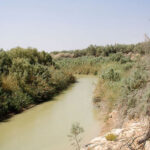Turkey has been in conflict with Syria and Iraq for quite some time over the Tigris and Euphrates River and who holds the rights to control them. These rivers begin in Turkey, who controls 98% of the water flow. The rivers flow southward towards Syria and Iraq. The Tigris mainly flows from Turkey into Iraq. Currently Turkey has many dams established that slow the amount of water Iraq can use. The Euphrates flows through Syria and then continues to Iraq. Iraq is worried that Syria and Turkey will use the water before it can reach Iraq due to the numerous dams set up along the river.
Turkey has created a program called GAP (South Eastern Anatolian Project). It has established 22 dams and 19 power plants along the Euphrates and Tigris basins. The goal of the project is to help Turkey’s farming and irrigation. Turkey wants to improve their irrigation, agriculture, and energy production. They have fourteen dams on the Euphrates basin and eight dams on the Tigris basin. The main part of the GAP program is called the Ataturk Dam, which is the third largest in the entire world. It spans almost six thousand feet across the Euphrates River. Since much of the Euphrates River starts in Turkey, the dam created a great controversy, especially when Turkey opted to fully hold the river in order to fill the reservoir for the dam. Currently this single dam reduces the amount of water Syria and Iraq receive by a third, creating a huge issue because not only is this one dam a large problem but they have thirteen more dams that go along the river before the water reaches Syria and then eventually Iraq.
Syria has been in conflict with Turkey due to the actions Turkey has taken with Syria’s access to water. In retaliation, Syria has been funding the terrorist organization called the PKK (Kurdistan Workers’ Party). They have announced their support of the PKK and have had them launch military operations against the Turkish army thus slowing the progression of the GAP program. This has caused major disruption to the construction of the dams along the Euphrates River. Studies claim that Syria could lose 40% of the water flow they had before the dams were set up. However, Iraq seems to be in far greater danger with a chance to lose 90% of their water. Syria’s main concern is that Turkey will then have control over the water flow. This could cause Turkey to control their market and agriculture.
Iraq’s issue is that they would not have any water once the water reaches their borders. Iraq is in greater danger; however, Turkey justifies it by saying that they can prevent Iraq from having droughts by saving the water in their reservoirs along the river and providing them with only what they need. Iraq says Turkey is not fulfilling their agreement to provide them with sufficient amounts of water during the summer when evaporation along the Euphrates and Tigris rivers is much higher.
Turkey realizes and understands Iraq and Syria’s needs for water. They need it for irrigation and overall well being, but Turkey is not willing to give up the water that they control to help Iraq and Syria. Iraq is at risk to not have enough water to sustain their population and agricultural needs. Syria has taken it to a military extent by funding the PKK to slow the progression of the dams. Clearly they need to have either external intervention from a stronger country or there needs to be an agreement met about how much water needs to be allowed to flow towards Syria and Iraq.
Burak Sansal, “GAP Project – All About Turkey.” All About Turkey.
Tevfik Emin Kor, “Tigris-Euphrates River Dispute.” American University
Jordi Tejel, “Syria’s Kurds: History, Politics and Society by Jordi Tejel – Google Books.” Google Books




